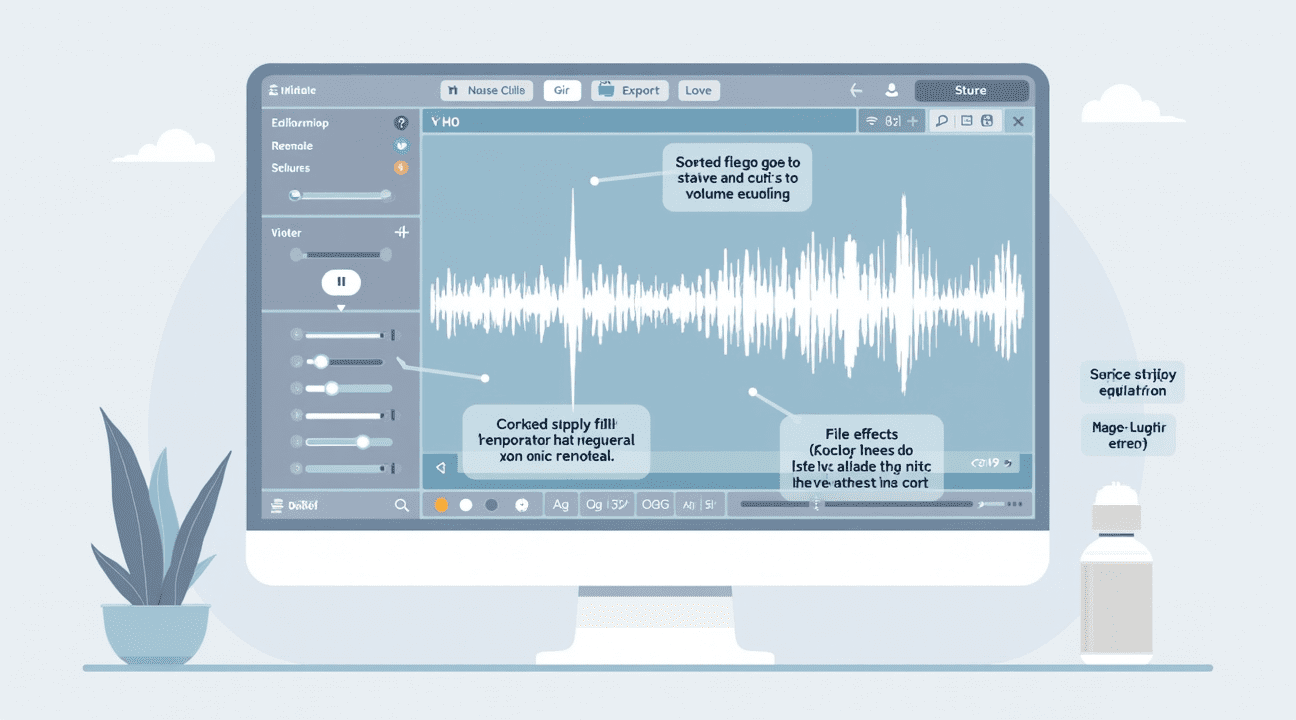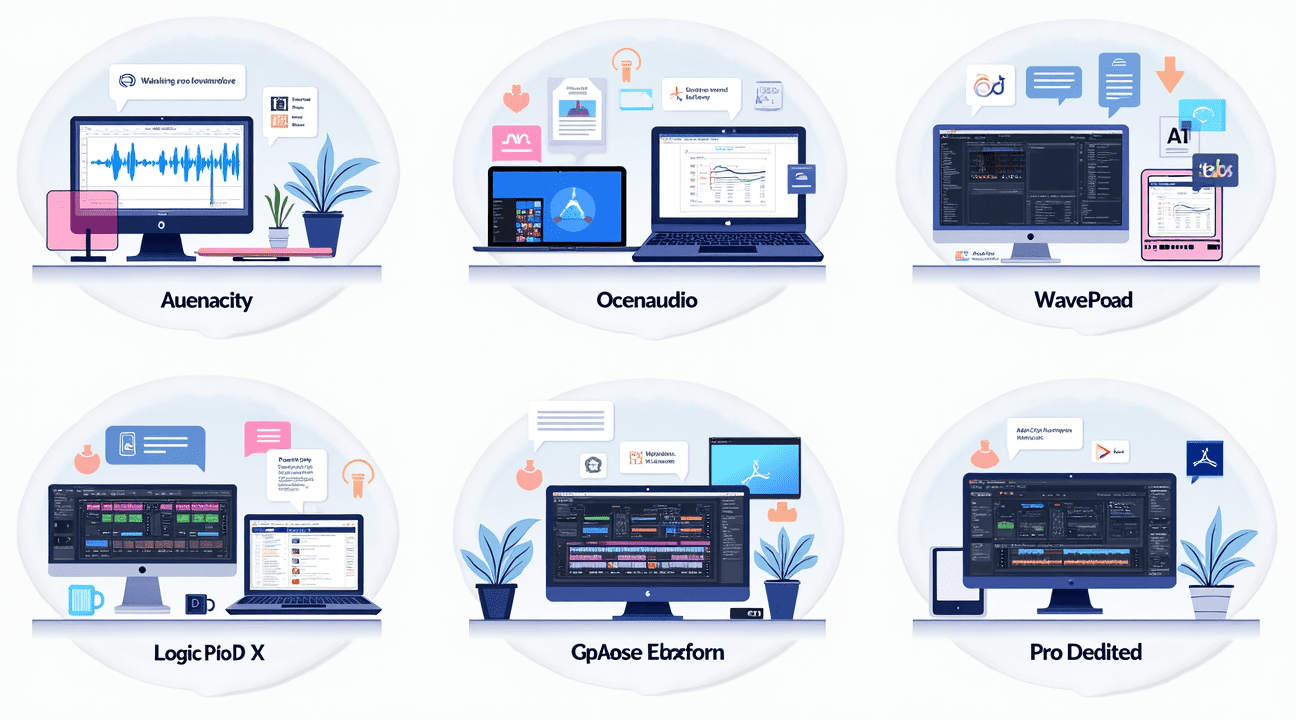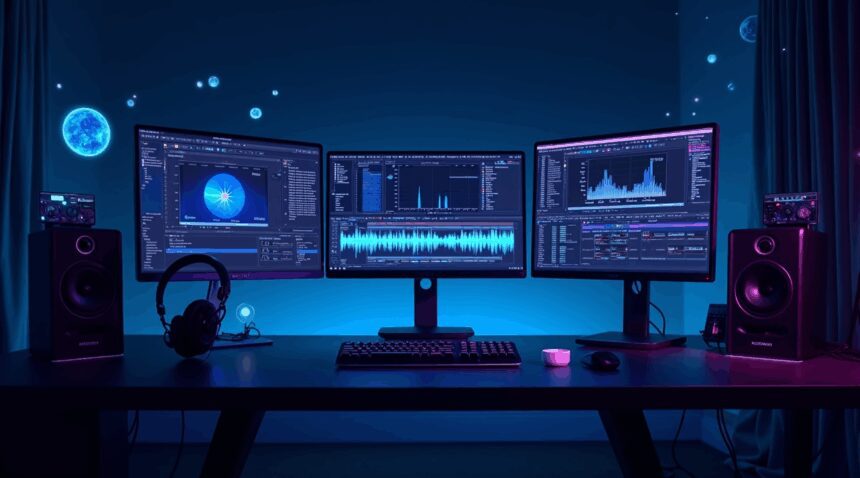The audio editing software market shows explosive growth, with projections reaching $5.4 billion by 2032. Podcasting, streaming, and accessible content creation tools drive this expansion while eliminating traditional barriers for beginners. This market growth creates an unprecedented opportunity for newcomers to access professional-grade audio editing tools through both free and premium options built specifically for ease of use.
Key Takeaways
- Free software champions like Audacity, GarageBand, Ocenaudio, and WavePad provide professional-quality features without financial investment, making them ideal starting points for beginners to develop core audio editing skills
- Premium tools such as Adobe Audition and Logic Pro X offer advanced capabilities and streamlined workflows that justify their cost for ambitious beginners planning serious audio production careers
- Essential beginner features include intuitive interfaces, built-in tutorials, multi-format support, basic editing functions (cut, trim, noise removal), and plugin compatibility for future growth
- Platform compatibility varies significantly, with cross-platform options like Audacity and Ocenaudio offering maximum flexibility, while Apple-exclusive tools like GarageBand provide seamless ecosystem integration for Mac users
- Real-world applications span content creation, podcasting, music production, and educational materials, with each software type excelling in specific areas like speech editing, multi-track recording, or batch processing capabilities
Why Audio Editing Markets are Exploding in 2025
I’ve watched the audio editing software industry transform dramatically over the past few years, and the numbers tell a compelling story. The global demand for user-friendly audio editors is surging at an unprecedented rate, with market projections that should grab every beginner’s attention.
The market size has exploded from approximately $2.5 billion in 2023 and is projected to reach over $5.4 billion by 2032. This reflects a compound annual growth rate (CAGR) of 8.9%, indicating sustained momentum that benefits newcomers to audio editing. More specifically, the audio and video editing software market is expected to reach $3.65 billion in 2025, up from $3.38 billion in 2024, with a CAGR of 7.9%.
Several factors contribute to this remarkable expansion. The rise in podcasting, streaming, and home music production has made beginner-friendly audio editors more available and sophisticated than ever before. Content creators no longer need expensive studio setups or years of training to produce professional-quality audio content.
Key Trends Shaping the Market
The industry is experiencing several transformative trends that specifically benefit newcomers:
- AI integration features such as noise reduction and automatic transcription eliminate technical barriers
- Cloud-based editing solutions allow access from anywhere without powerful hardware requirements
- Mobile-first solutions enable editing on smartphones and tablets
- Collaborative workflows support team projects and remote partnerships
- Virtual and augmented reality (VR/AR) features open new creative possibilities
Entry barriers like cost and complexity are decreasing significantly due to the availability of open-source and free alternatives. This democratization means beginners can start their audio editing journey without substantial upfront investment.
A significant driver of this growth stems from the surge in podcasting, which increases demand for accessible and intuitive audio editing tools. Content creators need software that can handle basic editing tasks without requiring extensive technical knowledge. This demand has pushed developers to prioritize user-friendly interfaces and automated features that simplify complex processes.
The market expansion also reflects broader shifts in content consumption habits. Streaming platforms continue to grow, creating opportunities for audio content producers across various niches. From audiobooks to music production, the appetite for quality audio content drives software innovation focused on accessibility and ease of use.
For beginners entering this space, the timing couldn’t be better. The combination of market growth, technological advancement, and reduced barriers creates an environment where anyone can access professional-grade tools and develop their audio editing skills effectively.

Top Free Audio Editing Champions Every Beginner Should Know
Getting into audio editing doesn’t require breaking the bank or wrestling with overly complex software. I’ve found that several exceptional free options exist specifically designed for newcomers to digital audio production. These programs offer professional-grade features while maintaining accessibility that won’t overwhelm first-time users.
Essential Free Audio Editors for New Audio Enthusiasts
Audacity stands as the most recommended tool for beginners venturing into audio editing. This free and open-source powerhouse delivers multi-track editing capabilities that rival many paid alternatives. Users benefit from real-time effects preview, which allows immediate feedback during the editing process. The software’s active community provides extensive support and documentation, making it perfect for podcasting, music editing, and basic audio corrections. Its cross-platform compatibility ensures seamless operation across Windows, Mac, and Linux systems.
GarageBand takes the crown for Apple users seeking an intuitive audio editing experience. This Apple-exclusive software integrates seamlessly with Mac and iOS devices, offering drag-and-drop loops and virtual instruments that transform audio editing into an engaging creative process. Built-in lessons guide users through fundamental techniques, while music creation tools expand beyond simple editing into full composition capabilities. The interface feels natural to anyone familiar with Apple’s design philosophy, making it an excellent starting point for Mac users.
Ocenaudio earns recognition as the best free audio editor for beginners according to TechRadar’s evaluation. Its streamlined interface focuses on essential tools without unnecessary complexity. The software excels at speech editing, making it particularly valuable for podcast creators and voice-over artists. VST plugin support expands functionality while maintaining the clean, customizable interface that promotes a fast learning curve. Cross-platform availability ensures users can work consistently across different operating systems.
WavePad distinguishes itself through exceptional ease of use and practical features that address real-world editing needs. Batch editing capabilities make repetitive tasks manageable, while single-track recording provides straightforward audio capture. The software supports a broad range of file formats, eliminating compatibility concerns that often frustrate beginners. Built-in tutorials accelerate the learning process, and the free license for non-commercial use makes it accessible to hobbyists and students. These features combine to create an ideal environment for those handling routine audio tasks.
Each of these editors brings unique strengths suited to different user preferences and workflows:
- Audacity‘s extensive community support makes it perfect for users who value documentation and shared knowledge.
- GarageBand‘s integration with Apple’s ecosystem provides unmatched convenience for Mac users.
- Ocenaudio‘s focus on speech editing serves content creators particularly well.
- WavePad‘s batch processing capabilities address efficiency concerns that arise with larger projects.
The beauty of starting with free software lies in the opportunity to explore different approaches without financial commitment. Users can experiment with multiple programs to discover which interface and feature set best matches their editing style. This exploration phase proves invaluable for developing preferences before potentially investing in premium software later.
These beginner-friendly options share common characteristics that make them accessible to newcomers:
- Simple interfaces reduce cognitive load during the learning process.
- Comprehensive file format support eliminates technical barriers.
- Built-in help systems provide immediate assistance when questions arise.
- Regular updates ensure compatibility with modern operating systems and audio formats.
The open-source nature of several options means continuous improvement driven by user feedback. This collaborative development model often results in software that better serves real user needs compared to commercial alternatives focused primarily on profit margins. Community-driven development also ensures long-term availability and support, providing confidence for users investing time in learning these tools.
Starting with any of these free champions provides a solid foundation for audio editing skills. The techniques learned transfer readily to more advanced software as needs grow. This progression path allows natural skill development without the pressure of expensive software licenses or complex feature sets that can overwhelm beginners trying to master basic concepts.
Professional Tools Worth the Investment for Ambitious Beginners
While free options work well for basic tasks, ambitious beginners benefit significantly from investing in professional-grade software that can grow with their skills. These premium tools offer advanced features and capabilities that streamline complex projects and deliver professional results.
Adobe Audition: Cloud-Based Professional Excellence
Adobe Audition stands out as a comprehensive solution for serious audio editing enthusiasts. This professional audio editing software provides multi-track editing capabilities that handle complex projects with ease. The platform’s advanced noise reduction technology removes background noise, clicks, and hums automatically, saving hours of manual cleanup work.
Audition’s integration with Adobe Creative Cloud creates powerful workflow opportunities for content creators working across multiple media formats. Users access the software through a subscription model, which includes regular updates and cloud storage benefits. Case studies reveal that beginners using professional tools like these experience significant productivity gains – similar to how flying car technology revolutionizes transportation efficiency.
The software excels at spectral frequency display, allowing users to visualize and edit specific frequencies within audio files. This feature proves invaluable for removing unwanted sounds or isolating specific elements within recordings. Advanced tools include real-time clip stretching, automatic speech alignment, and professional mastering effects that deliver broadcast-ready results.
Logic Pro X: Apple’s Professional DAW Solution
Logic Pro X represents Apple’s flagship professional DAW exclusively for macOS users. This software costs $199 as a one-time purchase, making it an attractive investment for Mac users serious about audio production. Despite its professional capabilities, Logic Pro X maintains a user-friendly interface that accommodates ambitious beginners while providing room for substantial growth.
The software includes an extensive plugin library featuring vintage EQs, compressors, and synthesizers that would cost thousands of dollars if purchased separately. Apple integration ensures seamless performance across Mac devices, with optimized processing that handles large projects smoothly. The precision editing tools allow sample-accurate editing, making it suitable for everything from podcast production to music composition.
Case studies demonstrate that tools like Audacity can reduce editing time by up to 40% for new podcasters, and similar efficiency gains apply to professional software when users master their capabilities. Logic Pro X’s automatic take folder organization and flex time features further accelerate workflow for users handling multiple recordings or complex timing adjustments.
Both professional options provide substantial value for beginners planning to develop serious audio editing skills, offering capabilities that justify their investment through improved workflow efficiency and professional-quality results.
Critical Features That Make or Break the Beginner Experience
The difference between a frustrating introduction to audio editing and a smooth learning journey often comes down to specific software features. I’ve found that certain elements consistently separate beginner-friendly programs from professional tools that overwhelm newcomers.
Interface Design and Learning Support
A clean, intuitive interface serves as the foundation for any beginner-friendly audio editor. The best software presents tools in logical groupings with clearly labeled buttons and menus that don’t require guesswork. Clean layouts prevent visual overwhelm while maintaining easy access to essential functions.
Built-in tutorials prove absolutely critical for reducing the initial learning curve. Software that includes step-by-step guides, tooltips, or interactive walkthroughs helps new users understand basic concepts without external resources. These educational elements transform potentially intimidating software into approachable learning platforms.
Essential Editing Capabilities
Effective beginner software must include fundamental editing functions that cover most basic audio projects. I recommend looking for these core capabilities:
- Cutting and trimming tools for removing unwanted sections
- Joining functions to combine multiple audio clips seamlessly
- Noise removal features to clean up background interference
- Pitch adjustment controls for correcting vocal recordings
- Basic effects library including reverb, echo, and equalization
- Simple volume and fade controls for smooth transitions
Multi-format support eliminates compatibility headaches that often frustrate beginners. Quality software should handle common formats like MP3, WAV, and OGG for both importing source material and exporting finished projects. This flexibility ensures users can work with existing audio files and share their creations across different platforms.
Plugin support provides growth potential without abandoning familiar software. While beginners shouldn’t feel pressured to use plugins immediately, having the option allows users to expand their capabilities as skills develop. The best beginner programs offer straightforward plugin installation and management systems.
The combination of accessible design and comprehensive basic features creates an environment where newcomers can focus on learning audio editing concepts rather than struggling with software mechanics. Programs that excel in these areas typically produce more confident users who continue developing their skills rather than abandoning audio editing altogether. Much like how flying car technology requires intuitive controls for mainstream adoption, audio editing software needs approachable interfaces to welcome new users effectively.

Detailed Software Comparison and Platform Compatibility Guide
When choosing audio editing software, platform compatibility often determines which options are available. I’ll break down the most popular software choices based on their operating system support and core features to help beginners make informed decisions.
Cross-Platform Solutions for Maximum Flexibility
Audacity stands as the most universally accessible option, running seamlessly on Windows, macOS, and Linux systems. This free software provides multi-track editing capabilities and includes comprehensive effects libraries that rival paid alternatives. The strong community support means beginners can find solutions to virtually any problem they encounter. However, users should expect an interface that feels dated compared to modern alternatives, and advanced features found in professional software remain absent.
Ocenaudio offers another cross-platform solution that works across Windows, macOS, and Linux environments. I find its simple setup process particularly appealing for newcomers who want to start editing immediately without wrestling with complex configurations. The software excels at dialogue editing and podcast production, featuring real-time effects that let users hear changes instantly. While this streamlined approach benefits beginners, those seeking advanced editing capabilities may find it limiting as their skills develop.
WavePad provides compatibility for both Windows and macOS users, offering free access for non-commercial projects while requiring payment for business use. The software supports an impressive range of file formats and includes helpful tutorial resources that guide beginners through common editing tasks. Unfortunately, the lack of built-in multi-track editing requires users to pair it with additional software for complex projects, much like how flying cars make their debut in the automotive industry – exciting in concept but requiring additional infrastructure.
Apple users enjoy exclusive access to GarageBand on both macOS and iOS devices. This free software provides an intuitive design that feels familiar to anyone using Apple products, with seamless integration across the Apple ecosystem. The software’s strength lies in its user-friendly approach and professional-quality results, though Windows and Linux users must look elsewhere for alternatives.
Logic Pro X remains exclusive to macOS users willing to invest $199 for professional-grade features. This one-time payment provides access to advanced tools that grow with users as they develop expertise, making it a solid long-term investment for serious Apple device owners.
Adobe Audition operates on both Windows and macOS through a subscription model that provides powerful professional features. While the learning curve can be steep for beginners, the comprehensive toolset justifies the ongoing cost for users who plan to pursue audio editing seriously. The subscription requirement means users must commit to recurring payments rather than one-time purchases available with other options.

Real-World Applications and Performance Benefits
Audio editing software transforms raw recordings into professional-quality content across multiple industries and creative pursuits. Content creators, podcasters, musicians, and hobbyists rely on these tools to polish their audio projects and deliver exceptional listening experiences to their audiences.
Essential Applications Across Different Fields
Content creators use audio editing software to enhance video productions, ensuring clear dialogue and balanced sound levels that keep viewers engaged. The software helps remove background noise, adjust volume levels, and synchronize audio with visual elements seamlessly.
Podcasters depend on these tools to create compelling episodes that retain listeners throughout each show. They remove unwanted pauses, eliminate filler words, and add intro music that establishes their brand identity. Musicians utilize audio editing capabilities to record demos, layer instruments, and experiment with different arrangements before entering professional studios.
Educational professionals and business presenters leverage audio editing to create clear instructional content and polished presentations. Even casual users find value in editing family recordings, creating personalized ringtones, or preparing audio for special events.
Platform-Specific Advantages and Performance Features
Audacity delivers exceptional value for users starting their audio editing journey without financial constraints. This open-source solution supports multi-track editing, allowing creators to layer multiple audio sources simultaneously. Its extensive effects library includes noise reduction, amplification, and echo removal that address common audio issues. The large community surrounding Audacity provides countless tutorials, plugins, and troubleshooting resources that accelerate the learning process.
GarageBand excels for Apple ecosystem users who want immediate creative results. Its drag-and-drop loop functionality enables quick song construction, while virtual instruments provide professional-quality sounds without additional hardware investments. Built-in lessons teach fundamental music theory and recording techniques, making it an educational tool alongside its editing capabilities. The seamless integration with other Apple applications streamlines workflow for users already invested in the platform.
Ocenaudio stands out with its clean interface design that minimizes learning curves for new users. Quick setup means creators can start editing within minutes of installation. Real-time effects processing allows users to hear changes immediately without rendering delays. The software particularly shines for dialogue editing and podcast production, where clear speech and consistent audio levels are paramount. Customization options let users arrange tools according to their specific workflow preferences.
WavePad addresses efficiency concerns through its batch processing capabilities, enabling users to apply identical edits across multiple files simultaneously. This feature proves invaluable for podcast series, audiobook chapters, or music albums requiring consistent processing. Tutorial videos integrated within the software guide users through complex procedures step-by-step. Support for numerous audio file formats eliminates compatibility issues when working with content from various sources.
Each platform delivers distinct performance advantages based on user needs and technical requirements. Free options like Audacity remove financial barriers while maintaining professional-grade functionality. Commercial solutions often provide enhanced customer support and additional features that justify their cost for serious creators.
The choice between platforms frequently depends on existing hardware, budget constraints, and specific project requirements. Mac users naturally gravitate toward GarageBand’s polished interface and ecosystem integration. Windows users often prefer Audacity’s versatility or WavePad’s comprehensive feature set. Cross-platform compatibility ensures creators can maintain consistent workflows regardless of their operating system preferences.
Performance benefits extend beyond basic editing capabilities to include workflow efficiency, learning curve management, and long-term scalability. Beginners appreciate intuitive interfaces that don’t overwhelm them with excessive options, while advanced users value the potential for growth within the same software ecosystem. The most effective audio editors balance accessibility with powerful features that accommodate users as their skills develop.
https://www.youtube.com/watch?v=YCSvXi7FXw0
Sources:
DevOpsSchool, “Top 10 Audio Editing Software Tools in 2025: Features, Pros, Cons, Comparison”
Data Insights Market, “Audio Editing Software: Market Growth Projections, 2025-2033”
Appy Pie Automate, “Best Audio Editing Software in 2025: A Guide for Creatives”
TechRadar, “Best free audio editor of 2025”
Data Intelo, “Audio Editing Software Market Report | Global Forecast From 2025”
G2, “9 Best Audio Editing Software I Recommend in 2025”
TBRC Blog, “Audio And Video Editing Software Market Trends 2025-2034”


